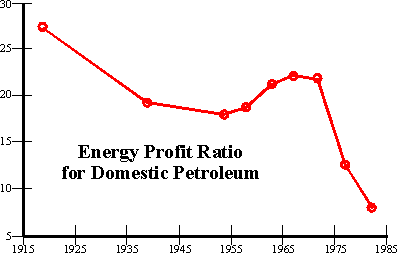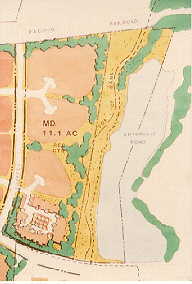 NOPEC --
Non-Oil Power Exporting Communities©
NOPEC --
Non-Oil Power Exporting Communities©The world will soon experience a calamity unparalleled in human history. As global environmental crises mount, increasing the demand for energy resources, we will be confronted with a rapid decrease in availability of the cheap resource which has fueled the rise of the modern economy and the information age. We will be forced, in a very short time, to abandon the oil economy.
EcoSystems is promoting NOPEC -- Non-Oil Power Exporting Communities -- to help create a viable world beyond oil. Is there any other way to meet the challenge?
Find out more about commitments being made by governments intending to become Non-Oil Power Exporting Countries.
 |
|---|
| Yield Per Effort, Oil and Gas ... after Hall & Cleveland, 1981 |
Our objective is to expand solar system applications beyond the HOUSE or industrial/commercial BUILDING to include consideration of all major infrastructure elements in a community. To encourage conventional developers to follow suit, EcoSystems and Altas are creating demonstration projects to include solar powered housing and transportation, advanced communications, recycling of water and waste, and non-petrochemical urban agriculture. The objective is to create a non-oil based community which ultimately will produce sufficient energy to export surplus power. This will require use of new technology, as well as economic self-reliance, to be accomplished with a multi-faceted employment base, including factories deriving energy from solar array "farms", telecommuting to reduce transportation requirements directly, and, by the nature of the project, strong emphasis upon education and R&D.
"Long range" in a society which sets its targets for quarterly corporate financial reports is perhaps not 50 years. And yet, the structures built in the next few years will certainly endure 50 years and longer.
What will our environment be like 50 years from now? For that matter, what will we find even 10 years from now? Recent research indicates that, in either time horizon, the planet may experience environmental disasters and resource depletions of unparalleled proportions.
As one feels the burden of dealing with the complex and increasingly overwhelming array of environmental crises, it is confusing to know what one individual can do. America and much of the industrial world is presently being spared the inconvenience and suffering from symptoms of our mismanagement of the planet's resources. These symptoms have surfaced in the developing world -- notably rain-forest destruction and desertification, which lead in turn to depravation and starvation. And yet, it is clear that such issues impact on everyone. But where does one start? If, for example, your urgent passion is to save the rain-forests, is it better that you go to the fringes of the Sahara Desert and begin a tree-planting project, or is it better to stay in the industrial world and lobby for legislation against importing exotic hardwoods from the Amazon?
One thing is clear: there is a significant net flow of goods from the impoverished and needy developing world to the wealthy and well-endowed industrial world. The resultant affluence may seem to be a benefit to the citizens of the industrial world. But affluence commands its price. Hard goods, whether derived from cheap foreign sources or more expensive domestic raw materials, are being produced by factories with toxic outfall, consumed and ultimately channeled into solid waste operations -- "land fills" -- at an awesome rate. Air pollution is unhealthy, even if it comes from more and fancier cars which have better pollution control equipment. Sitting in a traffic jam is a waste of time for the affluent and for the poor alike.
This is written in the context of the California experience, where population growth has been extraordinary in recent times, and is likely to continue unabated. In California, new construction is in full swing, based on the assumptions of unlimited fossil fuels and the good life. These assumptions are being challenged by economic realities which push the lower income segment of the population into progressively less tenable circumstances. And, these assumptions are being challenged by environmental realities as well. If today there is not a line at the gas pump, we know by simply looking up at the smoggy sky that we aren't doing everything right. In this context there are two major viewpoints which might shape future real estate development:
Extensive innovation is necessary to create sustainability. Funding for such innovation is subject to decisions made in the marketplace. That is, the impetus for building for a sustainable future will come as a consequence of a growing constituency, as a result of environmental changes taking place. NOPEC (Non-Oil, Power-Exporting Communities) was conceived to show citizens and leaders in our broader community what they have to gain by realizing this transformation -- from immediate gratification to taking responsibility for the needs of future generations. From Citizen to Community to City to Country, by definition, we will soon become a sustainable culture or we will face extinction as we join the ranks of endangered species. Our challenge is to find ways to adapt while preserving the best that modern technology has brought to us.
As the character of NOPEC is being defined, many questions are raised: What are the guiding principles? Where will it be built? When will it happen? Who will participate? How can it be accomplished within the economic realities of our culture?
Our goals are:
The NOPEC team is involved in various stages of development, ranging from negotiations for site acquisition, to permit approvals, to development financing, for several parcels in Northern California ranging in size from 10 to 3,500 acres. A status report on these and completed projects is included in the appendices.
To be feasible, project locations will be at the intersection of water, jobs, and sunshine. With satellite dish technology and telecommuting becoming commonplace, more diverse job opportunities are becoming available in remote locations. With modest water resources, drip irrigation and waste water reclamation, arid regions are also opened to modern human settlement.

The NOPEC project development team is composed of individuals from many disciplines. Profiles of potential residents are being prepared, on a project-by-project basis. The NOPEC strategy accommodates "hardliners" who require careful analysis and satisfactory economic performance, as well as concerned environmentalists who may not know how to translate their concerns into practical terms. The detailed structure of the team is presented in Chapter 5, Implementation.
We offer a multi-faceted strategy to achieve the goals of NOPEC. Stated simply, our formula for success is:
Our environmental strategy is based on recent changes in business and political perceptions of ecology. In the 1970's, "ecology" and "environment" were "fightin' words." In the 1980's, EIR's (Environmental Impact Reports) were viewed by developers as a necessary evil. In the 1990's, developers will begin to appreciate that good environment is good business.
Today the construction industry is building structures that will be in use in the post-petroleum era. For these structures, sustainability will be the key to economic feasibility. Nuclear and renewable energy systems will compete for the void created as fossil fuels are phased out as viable energy sources. Scarcity will impact direct costs, and environmental costs of oil, coal and other hydrocarbons will render these fuels unacceptable. Urban centers in the Southwestern USA will likely convert rapidly to solar electric once solar cells become competitive. Regardless of the debatable hazards of nuclear wastes, because of the dangers of sabotage in an unsettled world, it is likely that large-scale nuclear fusion systems will be phased out except for special high energy project requirements which justify the security risks.
The NOPEC strategy is to embrace these facts of life and express them in designs that will enlist enthusiastic cooperation of the business community and governmental agencies to produce tangible economic advantage for all participants.
Using the best commercially available technology, we design with specific attention to environmental trends in energy, land use planning, transportation, communications, housing construction, housing energy, agriculture, water, sewage treatment, and solid waste.
The NOPEC objective is to pre-discover the vernacular elements of development for the 21st century. NOPEC is intended to be a simple, frugal application of the emerging primary building blocks. For example:
In 19th century housing in America, the vernacular was the log cabin; in the 20th century, it has been the ranch house with 2x4 stud walls; in the 21st century it may well be the modular house with foam sandwich panel construction. Flexibility to reconfigure will be important -- people will stay in the same place, and rearrange their houses as family needs change.
In the 19th century, the prevailing new transportation systems were the horse and buggy, the train, and the steam ship; in the 20th century it has been the era of the automobile and the airplane; in the 21st century what it will be? Obviously cars will be lighter weight, semi-autonomous (perhaps not as autonomous as the automobile), and more energy efficient. Might it become the era of solar/electric vehicles and mag-lev rapid transit?
In the 19th century, it was the pony express and Morse Code. In the 20th century, the telephone, radio, television and computers enabled us to communicate rapidly around the world. In the twenty-first century, many communications options will be supported by the "Wired City".
Somewhere between the ho-hum and the blue sky is a happy medium for new development: where can we draw the line to achieve governmental approval, market acceptance, and economy?
The NOPEC team will create adaptive systems which deliver a fast response to social change. Flexibility in design will become very important -- for example, utility corridors ("utilidors") with capacity for expansion to avoid jack-hammering the streets for access, or modular partitions and movable closets in the home. If a family changes from single-parent to two parents, it will no longer be necessary to move to find adequate housing. Things will be rearranged and room modules will be added economically.
At each step, we define the economic advantages inherent in sustainable systems. Throughout, we consider the conditions likely to prevail during the useful life of the structures we build, which includes a time when oil will not be available.
Economic analysis is the basis for the allocation of capital. Going beyond the "bottom line," NOPEC considers the needs of future generations as well as the present, and surprisingly achieves economies along the way. We are accomplishing more with less -- the essence of any economic breakthrough.
NOPEC will achieve savings in initial capital (construction) costs by using the best available technology -- more efficient and elegant than the systems of the past.
Looking beyond the building phase, the NOPEC community must become economically self-sustaining also. Therefore, we are building a revenue base into the community through alliances with major corporations which offer environmentally sustainable products in the marketplace. NOPEC creates opportunities to showcase the best, as more corporations join in the spirit of sustainability. A variety of potential revenue streams are feasible, including university R&D parks, youth emancipation programs, organic agriculture integrated with housing, retirement communities, and solar energy farms.
This book is organized to give attention to specific elements of the NOPEC strategy in greater detail. Social and technological trends will be framed in terms of past, present, and anticipated future developments, to set the stage for integration into a coherent whole.
Anticipating our discussion of technological trends, we first define NOPEC with sensitivity to emerging social trends: in religion, community organization, economics, business structure, education, human labor (employment and unemployment), and housing.
Next we will give attention to trends in energy, infrastructure, communications, transportation, house construction, housing energy systems, organic agriculture, water, sewage treatment, and solid waste.
Modern government and management concepts have led our society to segregate many functions of community life which previously were associated with each other. For example, we have separate student communities and retirement communities; we have separate industrial parks and recreational parks. Building for NOPEC will entail reintegration of many facets of daily life. We review several methods for reintegration which promise economies as well as advantages in the human dimension. The outcome will be greater efficiency and a richer fabric of interrelated human activity.
The NOPEC organizational structure and methods are elaborated in the chapter on implementation. The importance of new planning and design tools is emphasized.
In an appendix, a review of previous projects by EcoSystems, Inc. and other NOPEC participants is given. One project especially, built in 1972, serves as a precedent for our ongoing work. The student housing project was built by students themselves under the supervision of EcoSystems at the University of California at Davis. It remains a very popular place for students to live, it has an enduring community spirit, and it was very economical to build.
A status report regarding ongoing NOPEC projects, a technology development, and a typical project schedule are also given in the appendices.
Technology Trends, Integration, Implementation, Conclusion
Appendices, BibliographySTRATEGY

Ecological Strategy -- Sustainability
![]()
Then...
![]()
...Now...
![]()
...Coming
Technology Strategy -- the vernacular
Housing
Transportation
Communications
How far can we go in technical terms?
Economic Strategy -- Savings and Revenue
Savings
Revenue
TRENDS, INTEGRATION, AND IMPLEMENTATION
Social Trends
Technology Trends
Integration
Implementation
Other sections coming soon!
![]() Back to EcoWebPress
Back to EcoWebPress
 Back to EcoSystems Home Page
Back to EcoSystems Home Page